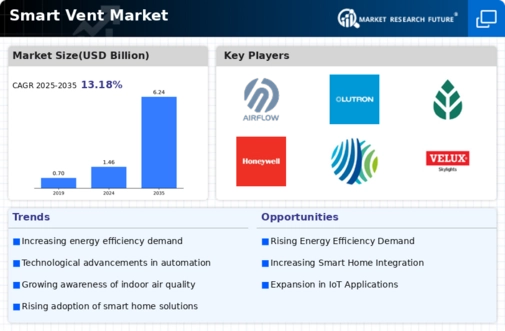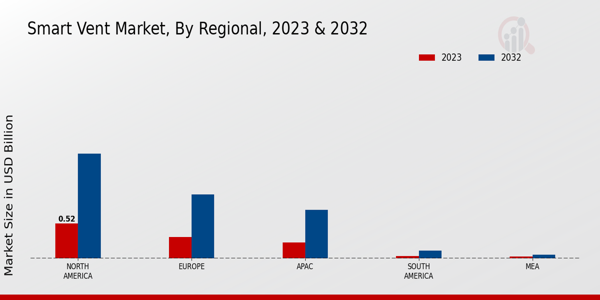Growing Smart Home Market
The expansion of the smart home market significantly impacts the Global Smart Vent Market Industry. As consumers increasingly invest in smart home technologies, the integration of smart vents becomes more appealing. These devices can seamlessly connect with other smart home systems, such as thermostats and security systems, creating a cohesive and efficient living environment. The synergy between smart home devices enhances user experience and drives demand for smart vents. This trend is expected to contribute to the market's growth trajectory, as more households embrace the convenience and efficiency offered by interconnected smart technologies.
Market Growth Projections
Rising Demand for Energy Efficiency
The Global Smart Vent Market Industry experiences a notable surge in demand for energy-efficient solutions. As energy costs continue to rise, consumers and businesses alike seek innovative technologies to optimize heating and cooling systems. Smart vents, which intelligently regulate airflow based on occupancy and temperature, present a viable solution. In 2024, the market is valued at 1.46 USD Billion, reflecting a growing awareness of energy conservation. This trend is expected to drive the market further as more individuals recognize the potential for reduced energy bills and enhanced comfort in their living spaces.
Government Initiatives and Regulations
Government initiatives and regulations aimed at promoting energy efficiency and sustainability are key drivers of the Global Smart Vent Market Industry. Many governments worldwide are implementing policies that encourage the adoption of smart technologies in residential and commercial buildings. Incentives such as tax credits and rebates for energy-efficient upgrades further stimulate market growth. These initiatives not only support environmental goals but also enhance public awareness of the benefits of smart ventilation systems. As a result, the market is likely to witness accelerated growth as regulatory frameworks evolve to support innovative solutions.
Increased Awareness of Indoor Air Quality
The Global Smart Vent Market Industry is significantly influenced by the growing awareness of indoor air quality (IAQ). As individuals become more conscious of the health implications associated with poor air quality, the demand for solutions that enhance IAQ rises. Smart vents, which can regulate airflow and filter pollutants, offer a practical approach to improving indoor environments. This trend is particularly relevant in urban areas where pollution levels are high. The market's projected growth to 6.24 USD Billion by 2035 indicates a strong correlation between health awareness and the adoption of smart ventilation solutions.
Technological Advancements in HVAC Systems
Technological advancements play a pivotal role in shaping the Global Smart Vent Market Industry. The integration of smart technology into heating, ventilation, and air conditioning (HVAC) systems enhances their functionality and efficiency. Innovations such as IoT connectivity and machine learning algorithms allow smart vents to adapt to user preferences and environmental conditions. As these technologies evolve, they are likely to attract more consumers, contributing to the market's growth. The anticipated compound annual growth rate of 14.11% from 2025 to 2035 underscores the importance of these advancements in driving market expansion.






















